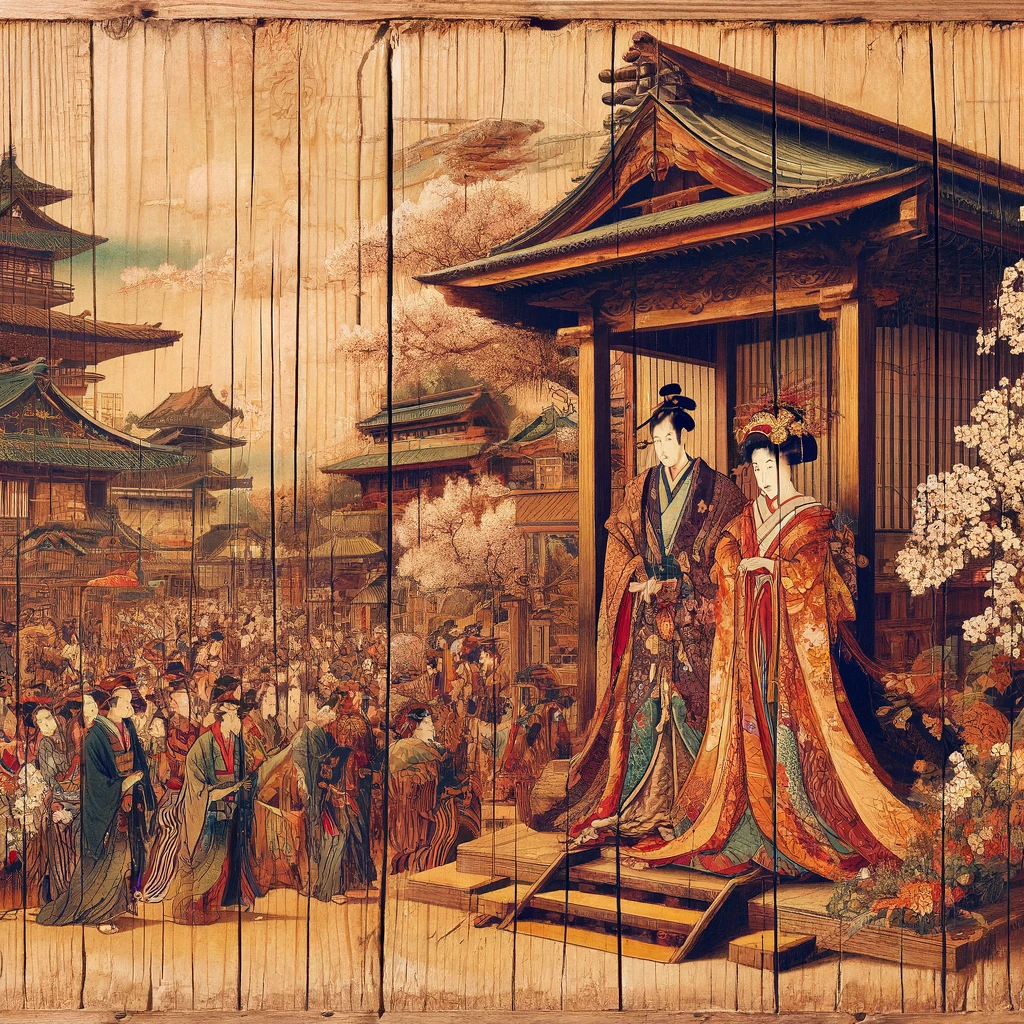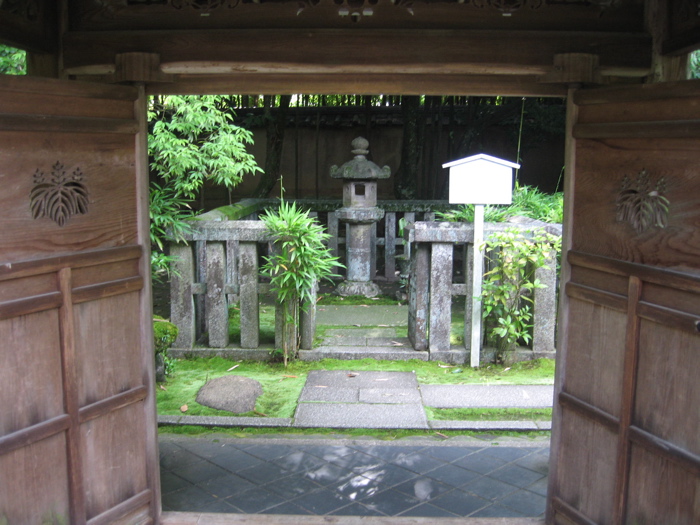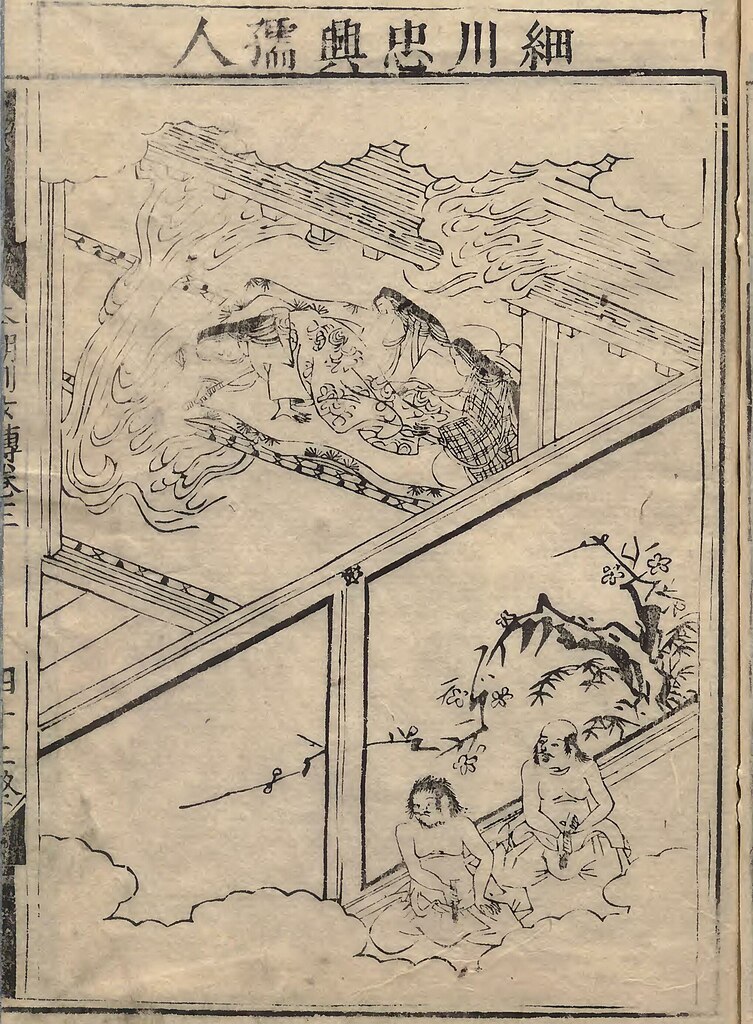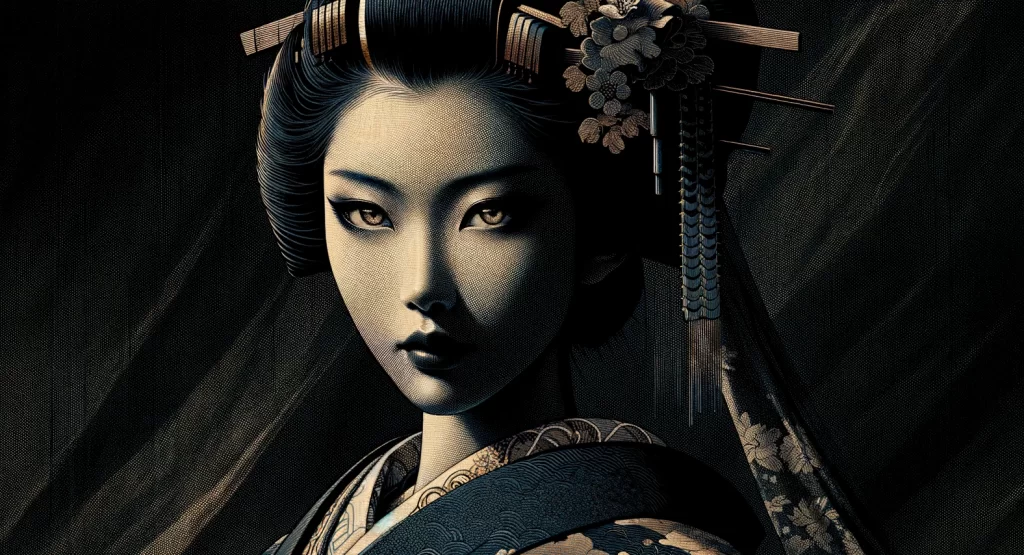Introduction
In the tumultuous era of the Sengoku period, a time characterized by relentless warfare, shifting allegiances, and the rise and fall of great samurai warlords, one figure stands out not for her prowess on the battlefield, but for her remarkable personal journey and enduring legacy. Hosokawa Gracia, born Akechi Tama, navigated the complexities of 16th-century Japan’s socio-political landscape with a grace and resilience that has captivated historians and cultural enthusiasts for centuries. Her story is not just one of survival in a time of chaos, but of profound transformation and unwavering faith.
Gracia was a noblewoman who found herself at the intersection of Japan’s tumultuous political struggles and the introduction of Christianity, a foreign faith that was both fascinating and controversial in a predominantly Buddhist society. Her conversion to Christianity, at a time when the religion was beginning to take root in Japan, marked her as a figure of both reverence and contention. The significance of Gracia’s faith went beyond personal belief; it influenced political alliances, social standing, and even her own family’s fate, encapsulating the broader tensions between traditional Japanese values and the encroaching influence of European powers.
This blog post aims to shed light on Hosokawa Gracia’s extraordinary life, exploring her early years, her transformative marriage, her bold embrace of Christianity, and the tragic yet heroic circumstances of her death. We will delve into her legacy, examining how her story has been remembered and celebrated in Japanese culture and what it reveals about the role of women in historical narratives. Through Gracia’s life, we glimpse the complexities of the Sengoku period and the enduring human spirit’s capacity for faith, love, and resilience amidst the tumult of history.
Early Life and Background
Born in 1563, Akechi Tama was a child of war and nobility, her life set against the backdrop of Japan’s Sengoku period, a century-long era of military conflict and social upheaval. As the daughter of Akechi Mitsuhide, a prominent samurai and general under the powerful daimyo Oda Nobunaga, Tama’s early years were steeped in the complexities of feudal loyalty and power struggles. Her lineage destined her for a life intertwined with the political machinations of Japan’s warrior class.
Tama’s childhood was marked by her family’s rising fortunes as her father, Mitsuhide, became increasingly influential in Nobunaga’s campaign to unify Japan. This environment, rich in martial valor and the strict codes of the samurai, was also one of intellectual and cultural vibrancy. The period saw an influx of foreign trade and the introduction of Christianity to Japan, factors that would later play a significant role in Tama’s life.
Despite the privilege and relative security her noble birth afforded, Tama’s early life was not insulated from the era’s turbulence. In 1582, her world changed irrevocably when her father betrayed Oda Nobunaga in the infamous Honnō-ji Incident, leading to Nobunaga’s death and a subsequent shift in Japan’s power dynamics. Mitsuhide’s betrayal and swift downfall—he was killed just days later in the Battle of Yamazaki—cast a shadow over Tama’s future, placing her in a precarious position within the samurai society, where loyalty and honor were paramount.
In the aftermath of her father’s betrayal and death, Tama’s fate took a pivotal turn through her marriage to Hosokawa Tadaoki, a young and ambitious samurai lord aligned with Nobunaga’s successor, Toyotomi Hideyoshi. This union, arranged while Tama was still a teenager, was emblematic of the alliances formed and dissolved in the Sengoku period’s chessboard of power. Tadaoki was a capable leader and a fervent supporter of Hideyoshi, who sought to continue Nobunaga’s work of unifying Japan. Through this marriage, Tama, now stepping into her role as Hosokawa Gracia, found herself at the heart of Japan’s ongoing transformation.
Gracia’s early life and marriage set the stage for her extraordinary journey from a noblewoman to a Christian convert in a society on the cusp of monumental change. Her story reflects the broader narratives of war, faith, and identity in a period that defined much of Japan’s historical trajectory.
Marriage and Transformation

The marriage between Akechi Tama, henceforth known as Hosokawa Gracia, and Hosokawa Tadaoki was not just a union of two individuals but a strategic alliance that reflected the tumultuous and ever-changing political landscape of feudal Japan. Tadaoki, a competent and ambitious samurai lord, was deeply involved in the efforts to unify Japan under Toyotomi Hideyoshi’s leadership. This marriage, therefore, positioned Gracia in a pivotal role within the socio-political sphere of the Sengoku period, linking her fate indelibly with the broader currents of Japanese history.
Gracia’s transformation from a noblewoman into a prominent Christian figure in Japan was both remarkable and indicative of the era’s complexities. Her introduction to Christianity and subsequent conversion were facilitated by the Jesuit missionaries who had begun to establish a foothold in Japan during the latter half of the 16th century. The Christian faith, with its novel teachings and foreign origins, was both a curiosity and a source of contention within Japan, a predominantly Buddhist and Shinto society.
The decision to embrace Christianity was significant for Gracia, marking a profound shift in her personal identity and spiritual beliefs. It was a choice that carried considerable risk, given the growing suspicion and eventual persecution of Christians by Japanese authorities. However, her conversion also reflected the broader cultural and religious exchanges taking place during this period, as Japan increasingly interacted with European powers.
Adopting the Christian name “Gracia” upon her baptism, she symbolized a new chapter in her life, one that distanced her from her past and aligned her with the global Christian community. This name, meaning “grace” in Spanish and Portuguese, was emblematic of her newfound faith and the transformative impact it had on her life.
Gracia’s conversion to Christianity had profound implications for her family. Tadaoki, though not a convert himself, was supportive of her faith, a stance that was both progressive and pragmatically motivated by the political and trading advantages that alliances with Europeans could offer. However, this religious affiliation also made the Hosokawa family targets for suspicion and hostility as the political tide in Japan turned against Christianity.
Gracia’s marriage and subsequent transformation into a Christian figure highlight her remarkable adaptability and resilience. Her story is a testament to the personal and collective challenges faced by those who navigated the complex social and political landscapes of the Sengoku period. Gracia’s life, marked by significant shifts in identity, faith, and allegiance, mirrors the broader transitions of Japan during one of its most tumultuous eras.
Life as a Christian in Feudal Japan
Hosokawa Gracia’s conversion to Christianity and her subsequent life as a Christian noblewoman in feudal Japan placed her at the confluence of significant cultural, religious, and political currents. Her faith, adopted during a period when Christianity was both a novelty and a controversy in Japan, set her apart in a predominantly Buddhist and Shinto society. This section explores the challenges she faced, the impact of her faith on her family’s political alliances, and the broader context of Christianity’s precarious position in Japan during the late 16th century.
Navigating Faith and Society
Gracia’s life as a Christian in feudal Japan was fraught with challenges. Christianity, introduced to Japan by Jesuit missionaries in the mid-16th century, was initially received with interest and even enthusiasm by some daimyo (feudal lords) and their retainers, fascinated by the foreign religion and its accompanying trade opportunities. However, as Gracia embraced her new faith, the political and social climate regarding Christianity began to shift. The religion, initially tolerated and even protected in some regions, increasingly came under suspicion. Authorities grew wary of its potential to undermine traditional Japanese values and the established social order, as well as its foreign influence.
For Gracia, practicing her faith meant walking a tightrope between her personal convictions and the need to navigate the complexities of her societal role. Despite these challenges, her conversion was a profound statement of personal agency and spiritual conviction, reflecting her willingness to embrace a belief system that resonated with her, even at great personal risk.
Impact on Family and Political Alliances
Gracia’s adoption of Christianity had significant implications for her family, particularly in terms of political alliances and social standing. Her husband, Hosokawa Tadaoki, though not a Christian himself, supported her faith, a decision that underscored the complexities of samurai loyalty, familial duty, and the strategic considerations of the time. This support was not without its risks; allegiance to Christianity could attract suspicion and hostility, potentially endangering the family’s position within the shifting power dynamics of feudal Japan.
The Hosokawa family’s association with Christianity, through Gracia, placed them in a unique position. On one hand, it facilitated connections with European traders and missionaries, offering access to firearms, Western knowledge, and new trade routes. On the other, it made them targets of anti-Christian sentiment, which grew as the Tokugawa shogunate began to consolidate power and enforce a policy of seclusion, aiming to curtail foreign influence and ensure the dominance of traditional Japanese religion and culture.
Christianity’s Precarious Position
By the time of Gracia’s death in 1600, Christianity’s position in Japan had become increasingly precarious. The initial openness to the Christian faith and its practitioners was giving way to suspicion, restrictions, and, eventually, persecution. The shogunate’s efforts to control foreign influence and maintain social order led to decrees banning Christianity, culminating in a policy that isolated Japan from the rest of the world for over two centuries.
Gracia’s life as a Christian in this context was emblematic of the broader struggles faced by converts during this transitional period. Her story highlights the tension between Japan’s engagement with the wider world and its desire to preserve its cultural integrity and autonomy. Gracia, through her faith, personal choices, and the challenges she faced, offers a window into the complex interplay of religion, politics, and identity in feudal Japan, demonstrating the profound impact of individual lives on the course of history.
The Siege of Tanabe
The Siege of Tanabe stands as a pivotal moment in the life of Hosokawa Gracia, emblematic of her indelible mark on Japanese history and her unique role during an era defined by war and shifting allegiances. In 1600, amidst the turbulent lead-up to the decisive Battle of Sekigahara, Tanabe Castle—under the stewardship of Gracia’s husband, Hosokawa Tadaoki—came under siege by forces loyal to Ishida Mitsunari, a leading figure opposed to Tokugawa Ieyasu, Tadaoki’s ally. This siege was not just a military confrontation but a crucible testing loyalty, strategy, and the enduring strength of personal convictions.
Gracia’s Role and Actions
Gracia’s presence in Tanabe Castle during the siege added a profound dimension to the conflict. Although not a combatant, her strategic significance stemmed from her familial connections and her status as a Christian noblewoman. The siege put Gracia in a precarious position, with the potential for her capture being used as leverage against Tadaoki and, by extension, Tokugawa Ieyasu.
The historical accounts suggest a blend of resolve and despair within the castle walls, as those inside braced for the possibility of defeat. Gracia’s conduct during this period reflects the stoicism and dignity attributed to her throughout her life. Yet, the most tragic and controversial aspect of the siege centers around her death. As the castle’s fall seemed imminent, Gracia died under circumstances that have since been the subject of much speculation and debate. Traditional narratives suggest that she was killed on orders from her husband, adhering to a grim samurai practice intended to prevent her capture and possible dishonor at the hands of the enemy.
The Tragic and Controversial Death

Gracia’s death is shrouded in layers of historical ambiguity, with interpretations ranging from an act of sacrifice to a strategic maneuver by Tadaoki to ensure his wife’s dignity and the safety of his house. This moment is often portrayed as a manifestation of the bushido code, emphasizing honor and duty above all, yet it also highlights the vulnerable position of women in samurai society, even those of noble birth like Gracia.
The aftermath of Gracia’s death saw Tadaoki emerging from the siege with his honor intact, largely due to the strategic implications of his actions and the eventual victory of Tokugawa Ieyasu at Sekigahara, which solidified the Tokugawa shogunate’s power. Gracia’s death, while a personal tragedy, played into the larger narrative of loyalty and sacrifice prevalent in samurai culture.
Reflection on the Siege’s Significance
The Siege of Tanabe, particularly through the lens of Gracia’s life and death, offers a poignant glimpse into the complexities of feudal Japan. It underscores the intertwining of personal honor, political strategy, and the human cost of warfare in an era defined by relentless conflict and transformation. Gracia’s story within the siege exemplifies the profound impact of individual agency against the backdrop of historical forces, highlighting the enduring human elements of courage, tragedy, and the quest for dignity in the face of overwhelming odds.
In reflecting on the Siege of Tanabe and Gracia’s role within it, one is compelled to consider the broader themes of loyalty, sacrifice, and the enduring legacy of those caught in the crucible of history. Gracia’s death not only marked the end of her personal journey but also symbolized the nuanced interplay of duty, honor, and personal conviction that characterizes so much of Japan’s samurai heritage.
Legacy and Cultural Impact
Hosokawa Gracia’s life story, culminating in her tragic death during the Siege of Tanabe, has transcended the historical records to become a significant part of Japan’s cultural and historical narrative. Her legacy, as a Christian noblewoman in feudal Japan, reflects the complex interplay of faith, gender, and societal norms during one of the country’s most tumultuous periods. This section explores the multifaceted impact of Gracia’s life and how she has been remembered and celebrated in Japanese culture.
A Symbol of Faith and Resilience
Gracia’s conversion to Christianity and her steadfast faith in the face of societal pressures and eventual persecution have made her a symbol of resilience and spiritual conviction. Her story resonates not just within the context of Christian history in Japan but also as a testament to the strength of individual belief against overwhelming external challenges. Her legacy is particularly poignant in light of the subsequent persecution of Christians in Japan, serving as a reminder of the early Christian community’s struggles and sacrifices.
Gracia in Literature and Drama
Hosokawa Gracia has been immortalized in various forms of Japanese literature and drama, reflecting her enduring appeal and the fascination with her life story. She has been depicted in Noh and Kabuki plays, novels, and historical dramas, each interpretation exploring different facets of her character, from her nobility and faith to her tragic death. These portrayals contribute to the mythologizing of Gracia, often emphasizing her virtue, dignity, and the dramatic circumstances of her life and death. Through these artistic expressions, Gracia has become an iconic figure, embodying themes of loyalty, sacrifice, and the clash between personal convictions and societal obligations.
Modern Media Representations
In modern times, Gracia’s story has been adapted into films, television series, and manga, highlighting her continued relevance and the enduring fascination with her life. These contemporary portrayals often focus on her strength, her role as a woman navigating the male-dominated society of feudal Japan, and her unique position as a Christian convert. By bringing her story to new audiences, modern media keeps Gracia’s legacy alive, prompting reflections on faith, identity, and the role of women in history.
Symbolic Significance and Cultural Reflection

Hosokawa Gracia’s legacy goes beyond the historical specifics of her life, offering insights into broader themes in Japanese history and culture. She serves as a window into the Sengoku period, a time of significant change, conflict, and cultural exchange. Gracia’s story also prompts reflection on the role of women in historical narratives, challenging traditional portrayals and highlighting the complexity of women’s experiences and contributions during periods of societal upheaval.
Moreover, her legacy as a Christian noblewoman in a predominantly Buddhist and Shinto society raises questions about religious tolerance, cultural exchange, and the impact of foreign influences on Japanese identity. Through her life and legacy, Gracia represents the intersections of faith, politics, and personal integrity, inviting ongoing exploration and discussion of her place in Japan’s rich tapestry of history and culture.
Hosokawa Gracia remains a fascinating figure in Japanese history, her life story encapsulating themes of courage, faith, and tragedy that continue to resonate. As a symbol of resilience, a subject of artistic interpretation, and a focal point for cultural reflection, her legacy endures, highlighting the enduring human capacity for faith, love, and resilience amidst the tumult of history.
Conclusion
The story of Hosokawa Gracia is a poignant narrative woven into the rich tapestry of Japan’s history, encapsulating the essence of an era marked by war, transformation, and the clash of cultures. As a Christian noblewoman navigating the complex socio-political landscapes of the Sengoku period, Gracia’s life story is a testament to the enduring strength of the human spirit in the face of adversity. Her conversion to Christianity, her strategic significance within the samurai hierarchy, and her tragic demise during the Siege of Tanabe illuminate the multifaceted challenges faced by individuals during times of profound change.
Gracia’s legacy, preserved through literature, drama, and modern media, continues to inspire and fascinate, serving as a reminder of the complexities of historical narratives and the role of women within them. Her life prompts us to reflect on themes of loyalty, sacrifice, and the pursuit of personal convictions against overwhelming societal pressures. Moreover, Gracia’s story offers insights into the broader cultural and religious dynamics of feudal Japan, highlighting the impacts of foreign influences and the tensions between traditional Japanese values and the encroaching global forces.
The enduring fascination with Hosokawa Gracia’s life and legacy speaks to her significance not just as a historical figure but as a symbol of resilience, faith, and the complexities inherent in the human condition. Her story transcends the specifics of her time, inviting modern audiences to consider the intersections of faith, politics, and personal integrity. As we delve into her narrative, we are reminded of the lessons history can teach us about the capacity for courage, the importance of personal beliefs, and the enduring impact of individual lives on the course of history.
In conclusion, Hosokawa Gracia’s life story enriches our understanding of the Sengoku period and offers a compelling perspective on the role of women in shaping historical narratives. Through her, we glimpse the human elements that underpin historical events—the struggles, choices, and enduring spirits that continue to resonate across time. Gracia’s legacy, marked by tragedy but also by a profound sense of dignity and faith, encourages ongoing exploration and appreciation of the nuanced tapestry of Japan’s past, reminding us of the power of individual stories to inform, inspire, and illuminate the complexities of human history.
Additional Resources
For those interested in delving deeper into the life of Hosokawa Gracia, her role in the Sengoku period, and the broader context of Christianity in Japan, a wealth of resources is available. From academic texts to novels, films, and digital archives, the following recommendations offer various perspectives and insights into this fascinating period of Japanese history and the extraordinary life of one of its most intriguing figures.
Books and Academic Texts
- “Samurai Women, 1184–1877” by Stephen Turnbull – This book provides insights into the lives of women during Japan’s samurai era, including Hosokawa Gracia. It offers context on their roles and challenges in a predominantly male-dominated society.
- “Christianity in Early Modern Japan: Kirishitan Belief and Practice” by Ikuo Higashibaba – A comprehensive study on the introduction, spread, and eventual persecution of Christianity in Japan, providing a backdrop to Gracia’s conversion and the challenges faced by Christians.
- “The Samurai’s Wife” by Laura Joh Rowland – A historical novel that, while fictional, offers an engaging portrayal of the kind of life Gracia might have led, set against the backdrop of feudal Japan and its complexities.
Documentaries and Films
- “Silence” (2016) directed by Martin Scorsese – Though not about Gracia directly, this film explores the persecution of Christians in Japan and provides a vivid depiction of the period’s religious and cultural tensions.
- “Kunitori Monogatari” (1973, TV Series) – A Japanese historical drama series that features the life of Hosokawa Gracia among other historical figures of the Sengoku period, offering a dramatized glimpse into her life and era.
Online Resources and Digital Archives
- “Virtual Museum of Japanese Arts” – Offers digital exhibitions on various aspects of Japanese culture and history, including the Sengoku period. It’s a valuable resource for understanding the cultural context of Gracia’s life.
- “The Samurai Archives” – An extensive digital resource dedicated to the samurai history of Japan. It contains articles, historical texts, and forums for discussion, providing deeper insights into the era of Hosokawa Gracia.
- “Project Gutenberg’s Collection of Japanese Literature” – Offers translated works of Japanese literature, including historical accounts and literary works from the Sengoku period, allowing for a deeper cultural understanding of the era.
Academic Journals and Databases
- JSTOR and Project MUSE – These academic databases contain numerous scholarly articles and papers on Japanese history, including specific research on Hosokawa Gracia, the role of women in the samurai class, and the Christian experience in Japan.
These resources collectively offer a multifaceted view of Hosokawa Gracia’s life and the world in which she lived. Whether through academic study, literature, or visual media, exploring these materials can enrich one’s understanding of Gracia’s significance and the enduring legacy of her remarkable story.

